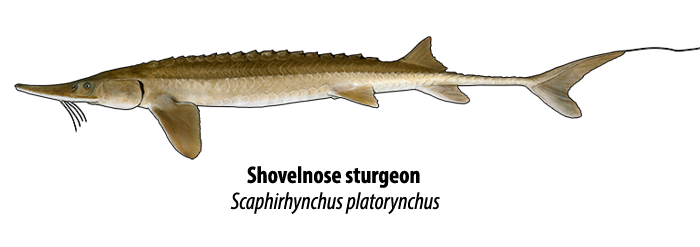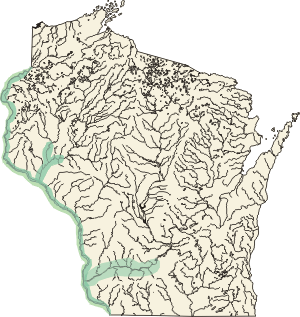Shovelnose sturgeon
Fishing Wisconsin
Identification
Description: The shovelnose sturgeon is similar to the lake sturgeon in that its body is angular (5 sided) and torpedo-shaped with 5 rows of bony plates (called scutes): 14-19 dorsal plates, 38-47 lateral, 10-14 ventrolateral. However, the shovelnose sturgeon's body is much more elongated. Adult fork length (tip of snout to fork in the tail) is about 635 mm (25 in). The snout is long and very spade-like. Unlike the lake sturgeon, there is no spiracle. The caudal peduncle (area in front of the tail) is slender, depressed, and completely encased in bony plates. Lower lip with 4 lobes. Barbels strongly fringed. The tail is heterocercal with the upper lobe of the tail fin is elongated into a threadlike extension (often broken off).
Color: Adults are olive to yellowish-brown above, sides lighter, and white below.
Distribution
The shovelnose sturgeon occurs only in the Mississippi drainage basin, appearing in the Mississippi River, the Wisconsin River upstream to the Prairie du Sac Dam, the St. Croix River upstream to St. Croix Falls Dam, the Chippewa River up to the Eau Claire Dam, and the Red Cedar River upstream to the Menomonie Dam. Its presence in the Black River upstream to Black River Falls Dam is suspected but not documented. In Wisconsin, it is uncommon to common in the main channels of the Mississippi and lower Wisconsin rivers and in the lower Chippewa and Red Cedar rivers. Numbers in the Mississippi River have decreased sharply since the turn of the century.
Habits
Like lake sturgeon, shovelnose are restricted to living on small organisms - snail, insect larvae, leeches, small clams, and other invertebrates. To locate food, the shovelnose sturgeon will rake the bottom with the sensitive barbels that hang down from the snout. The highly protrusible lips are adapted to sucking. The shovelnose sturgeon is believed to be an opportunistic feeder, whose food intake is controlled by availability.
Movement studies have shown that shovelnose sturgeon are capable of making significant journeys. Fish have been shown to move in excess of 120 miles. At times, they tend to congregate in the tailwaters of pools. During high-water years, the dam-control gates are out of operation much of the time and are no longer barriers to upstream movement.
Reproduction and Development
Shovelnose sturgeon spawning in Wisconsin occurs during May and June. In the Red Cedar-Chippewa rivers during 1972, shovelnose sturgeon spawned the last week in May through the first week in June at water temperatures of 19.5-21.1 C (67-70 F). In the St. Croix River (Wisconsin-Minnesota boundary water) large numbers migrate up from Lake St. Croix and gather under the dam at St. Croix Falls, where they spawn on the rocks in the swift water below the dam.
It is generally accepted that shovelnose sturgeon migrate upstream for spawning, and migrations into smaller streams have been reported. Spawning migrations in the Mississippi River can be variable: best when the river is low in spring and poor when it is high. It is believed that the species seeks an optimal volume of flow, departing from the largest rivers to enter tributaries for spawning in years when streams are high.
In shovelnose sturgeon from the Chippewa River, the adhesive eggs appear to fall into three major groups: (1) yellow and/or white, (2) white and black, and (3) black (the mature eggs in the enlarged ovaries). Since at least three stages of egg development occurred essentially without relation to the size of the female, it is apparent that females do not spawn every year; but the spawning chronology is not readily evident. Females generally produce 10,000 - 50,000 eggs.
Little is known about the early development of the shovelnose sturgeon. The young-of-year are as small as 43 mm (1.7 in) FL were taken in the upper Mississippi River during late June by trawling. All successful trawl tows were rather far from shore; they were usually located in the main channel or main channel border habitat. The most successful hauls were those associated with submerged rock wing dams. Young taken on July 11th from the Mississippi River at Fairport measured 71 mm SL.
On the Mississippi River female shovelnose sturgeon mature at age VII, while most males spawn at age V. Only one age-V female was found with developing eggs. An investigation of the sexual maturity of 374 males and 503 females from fish markets at Lansing and Muscatine, Iowa, determined that of fish under 635 mm (25 in) FL, 25% of the males and 7% of the females were mature; over 635 mm (25 in) FL, 62% and 58%, respectively.
Mississippi River shovelnose sturgeon length at age
| Age (years) | Length (inches) |
|---|---|
| 1 | 10.5 |
| 3 | 19.0 |
| 5 | 20.7 |
| 7 | 23.8 |
| 9 | 25.9 |
| 11 | 27.1 |
Environmental Concerns
Preservation of habitat is the single most important factor in maintaining conditions for the survival of the shovelnose sturgeon. Populations of shovelnose sturgeon are undoubtedly much lower now than they were when the Mississippi River was a natural, unimpounded watercourse. The decline was undoubtedly a direct result of habitat destruction. Manipulation of the river to enhance navigation (including the construction of 4-, 6-, and 9-ft channels) and establishment of impoundments have constricted shovelnose sturgeon habitat to small areas immediately downstream from navigation dams.
Changes in habitat have seriously reduced the capacity of our waters to produce these fish. Dams prevent the fish from traveling to their spawning grounds, and the change in water flow brought about by hydroelectric power plants may reduce the number of bottom organisms shovelnose sturgeon feed on and interfere with the hatching of sturgeon eggs. Like many fish, sturgeon require stable, moderate levels of oxygen to survive. Polluted waters have less available oxygen; in winter and midsummer, these oxygen levels may drop too low, resulting in death for the shovelnose sturgeon and other species.
Sturgeon that live in polluted waters may accumulate some pollutants in their tissues at high concentrations in part because they are long-lived but also because they can have high levels of fat. Wisconsin's statewide fish consumption advisory recommends that women of childbearing years and children not eat sturgeon more frequently than one meal per month and men and older women not eat sturgeon more frequently than one meal per week.


